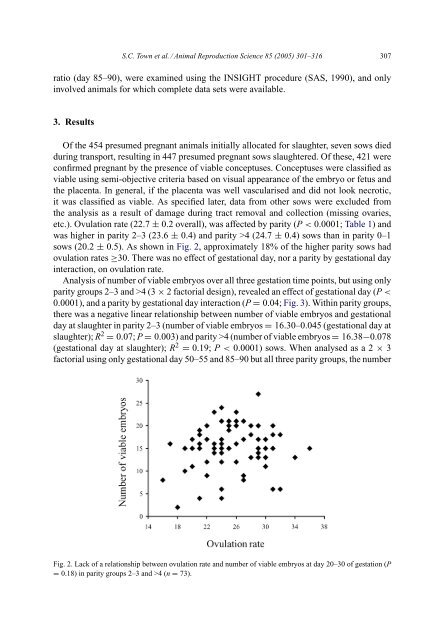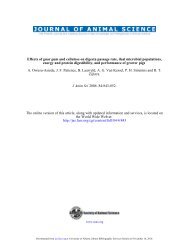306 S.C. Town et al. / Animal Reproduction Science 85 (2005) 301–316cell of data for some reproductive characteristics. However, ovulation rate <strong>and</strong> number ofviable conceptuses were recorded for all other females (Table 1, Figs. 3 <strong>and</strong> 4). As a reviewof available literature (Town, 2004) suggested that extremes of <strong>in</strong> utero <strong>development</strong> areassociated with the ovarian <strong>and</strong> cervical ends of the uter<strong>in</strong>e horn, two conceptuses weredissected from each mid-uter<strong>in</strong>e horn on day 20–30 <strong>and</strong> embryonic <strong>and</strong> placental weightsrecorded, thus provid<strong>in</strong>g a conservative measure of overall effects on embryonic <strong>development</strong>.Aga<strong>in</strong>, to avoid extremes of <strong>development</strong> determ<strong>in</strong>ed by <strong>fetal</strong> position <strong>in</strong> utero,one representative fetus was selected from each mid-uter<strong>in</strong>e horn on day 85–90 tract (n= 166), <strong>and</strong> used to record <strong>fetal</strong> <strong>and</strong> placental weights. The fetuses were then dissectedto determ<strong>in</strong>e bra<strong>in</strong> <strong>and</strong> liver weights. The bra<strong>in</strong>:liver weight ratio was then used as an estimateof disproportionate changes <strong>in</strong> organ <strong>development</strong>, <strong>in</strong>dicative of the occurrence ofIUGR.2.3. Statistical analysisTo determ<strong>in</strong>e the effects of parity group, gestation day <strong>and</strong> their <strong>in</strong>teraction on ovulationrate, embryonic survival rate, number of viable embryos, placental <strong>and</strong> <strong>fetal</strong> weights, placentalefficiency <strong>and</strong> <strong>fetal</strong> bra<strong>in</strong>:liver weight ratio, data were analysed as appropriate fora completely r<strong>and</strong>omised design. Sow was used as the experimental unit for analysis, <strong>and</strong><strong>fetal</strong> weights, placental weights <strong>and</strong> organ weights were sub-sampled <strong>and</strong> averaged with<strong>in</strong>each reproductive tract (sow) before analysis. As logistical constra<strong>in</strong>ts prevented collectionof embryo data from day 20–30 parity 0–1 animals, different statistical models were used toanalyse parameters of <strong>in</strong>terest <strong>and</strong> thus extract the most <strong>in</strong>formation from the data available.Ovulation rate data were complete for all n<strong>in</strong>e groups of animals, <strong>and</strong> therefore, wereanalysed as a 3 × 3 factorial for parity group <strong>and</strong> gestational day us<strong>in</strong>g the general l<strong>in</strong>earmodel (GLM) procedure of the statistical analysis system (SAS, 1990, SAS Inst. Inc., Cary,NC). Due to miss<strong>in</strong>g embryo data from the day 20–30, parity 0–1 group (see Table 1),embryo survival rate <strong>and</strong> the number of live embryos were first analysed as a 3 × 2 factorial(us<strong>in</strong>g only data from parity 2–3 <strong>and</strong> parity >4 sows, at all gestational days, to exam<strong>in</strong>eprimarily the effect of gestational day). Number of viable fetuses <strong>and</strong> <strong>fetal</strong> survival datawere then analysed as a 2 × 3 factorial us<strong>in</strong>g only gestational day 50–55 <strong>and</strong> 85–90, but allthree parity groups, to exam<strong>in</strong>e primarily the effect of parity.S<strong>in</strong>ce placental <strong>and</strong> <strong>fetal</strong> data were only obta<strong>in</strong>ed from day 20–30 animals <strong>and</strong> 85–90animals, the effect of parity on conceptus <strong>development</strong> at these time po<strong>in</strong>ts was furtherexam<strong>in</strong>ed by analys<strong>in</strong>g placental <strong>and</strong> embryonic/<strong>fetal</strong> weights both as a 2 × 2 factorialus<strong>in</strong>g data from gestational day 20–30 <strong>and</strong> 85–90 <strong>and</strong> parity groups 2–3 <strong>and</strong> >4, <strong>and</strong> us<strong>in</strong>gdata for all three parities <strong>and</strong> gestational day 85–90. The effect of parity on bra<strong>in</strong>:liverweight ratio, was also exam<strong>in</strong>ed us<strong>in</strong>g data for all three parities <strong>and</strong> gestational day 85–90.Trends analysis (Steel et al., 1997) was used to determ<strong>in</strong>e if there was a l<strong>in</strong>ear relationshipbetween gestation day <strong>and</strong> both embryonic/<strong>fetal</strong> survival rate <strong>and</strong> the number ofviable embryos/fetuses. The Tukey–Kramer test (SAS, 1990) was used for mak<strong>in</strong>g pairwisecomparisons between least squares means.Relevant associations with<strong>in</strong> gestational age between ovulation rate, number of viable embryos,<strong>fetal</strong> weight, placental weight, placental efficiency (calculated as the <strong>fetal</strong>:placentalweight ratio; day 20–30 <strong>and</strong> 85–90), <strong>and</strong> <strong>fetal</strong> bra<strong>in</strong> <strong>and</strong> liver weights <strong>and</strong> bra<strong>in</strong>:liver weight
S.C. Town et al. / Animal Reproduction Science 85 (2005) 301–316 307ratio (day 85–90), were exam<strong>in</strong>ed us<strong>in</strong>g the INSIGHT procedure (SAS, 1990), <strong>and</strong> only<strong>in</strong>volved animals for which complete data sets were available.3. ResultsOf the 454 presumed pregnant animals <strong>in</strong>itially allocated for slaughter, seven sows dieddur<strong>in</strong>g transport, result<strong>in</strong>g <strong>in</strong> 447 presumed pregnant sows slaughtered. Of these, 421 wereconfirmed pregnant by the presence of viable conceptuses. Conceptuses were classified asviable us<strong>in</strong>g semi-objective criteria based on visual appearance of the embryo or fetus <strong>and</strong>the placenta. In general, if the placenta was well vascularised <strong>and</strong> did not look necrotic,it was classified as viable. As specified later, data from other sows were excluded fromthe analysis as a result of <strong>dam</strong>age dur<strong>in</strong>g tract removal <strong>and</strong> collection (miss<strong>in</strong>g ovaries,etc.). Ovulation rate (22.7 ± 0.2 overall), was affected by parity (P < 0.0001; Table 1) <strong>and</strong>was higher <strong>in</strong> parity 2–3 (23.6 ± 0.4) <strong>and</strong> parity >4 (24.7 ± 0.4) sows than <strong>in</strong> parity 0–1sows (20.2 ± 0.5). As shown <strong>in</strong> Fig. 2, approximately 18% of the higher parity sows hadovulation rates ≥30. There was no effect of gestational day, nor a parity by gestational day<strong>in</strong>teraction, on ovulation rate.Analysis of number of viable embryos over all three gestation time po<strong>in</strong>ts, but us<strong>in</strong>g onlyparity groups 2–3 <strong>and</strong> >4 (3 × 2 factorial design), revealed an effect of gestational day (P 4 (number of viable embryos = 16.38−0.078(gestational day at slaughter); R 2 = 0.19; P < 0.0001) sows. When analysed as a 2 × 3factorial us<strong>in</strong>g only gestational day 50–55 <strong>and</strong> 85–90 but all three parity groups, the numberFig. 2. Lack of a relationship between ovulation rate <strong>and</strong> number of viable embryos at day 20–30 of gestation (P= 0.18) <strong>in</strong> parity groups 2–3 <strong>and</strong> >4 (n = 73).




